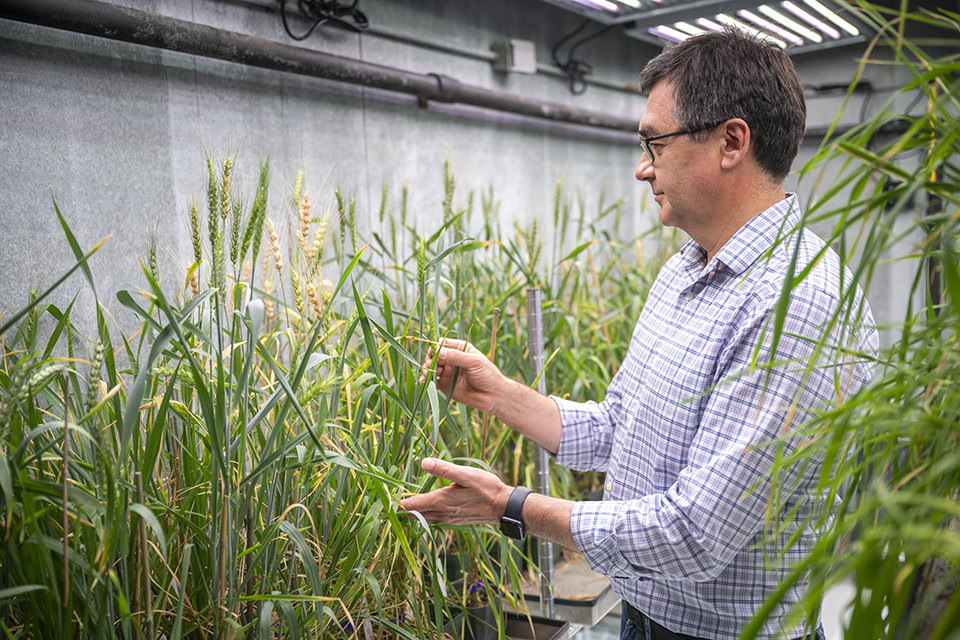Nourishing food innovation
One grain at a time, K-State researchers drive advances in plant and cereal science
Whether it’s to make healthier bread, tastier burgers or younger looking skin, researchers at Kansas State University are driving transformative innovations in grain and plant science.
Inside the humble loaf of bread lies a biological progression that parallels humanity’s spread around the globe. Wheat genetics are a record of the plant’s rich history, and recent breakthroughs in sequencing are mapping its genome and revealing the potential for future resilience and nutritional improvements.
“For wheat, high genetic diversity is crucial for developing improved crops and adapting to changing conditions,” said Eduard Akhunov, professor of plant pathology and director of the Wheat Genetics Resource Center at Kansas State University. “CRISPR is a new way of generating this diversity — with recent developments in this technology, we can edit not just a single gene or a dozen genes, but hundreds, and do it relatively quickly.”
Akhunov’s latest work — CRISPR-modified wheat that reduces gluten toxicity without affecting bread-dough quality — exemplifies the trend for ‘consumer-minded’ food research, which prioritizes health and sustainability alongside crop yield.
With a comprehensive plant pathology program and one of the world’s few grain science programs, K-State brings cutting-edge research in biotechnology, food processing and proteins directly to the plate — or the pet food bowl.
 Eduard Akhunov and his team of plant pathologists work on developing resources and tools for improving bread wheat.
Eduard Akhunov and his team of plant pathologists work on developing resources and tools for improving bread wheat.
Wheat’s wild roots enhance diversity
The wheat used to bake bread is hexaploid, having six sets of chromosomes and multiple copies of the same gene, which evolved through successive natural hybridizations and genome-doubling events among ancestral grasses.
Much of Akhunov’s work focuses on understanding how such genetic redundancy shapes wheat’s agronomic traits. Increasingly, wheat’s wild relatives are critical to unlocking this complexity.
Akhunov recently led an international study that sequenced nearly 1,000 wheat lines from distinct geographic regions that span a wide range of global environments. When comparing genomes, the researchers found chromosome segments from key wild ancestors of modern wheat.
“Early forms of domesticated wheat come from the narrow geographic range where humans lived 10,000 years ago,” Akhunov said. “As humans carried wheat to new regions, it encountered wild ancestors again, leading to accidental crossbreeding. This process enriched wheat genetic diversity and likely was used to develop wheat adapted to various climatic conditions, including drought and heat stress.”
Akhunov and his team at the Kansas Wheat Innovation Center, which holds a gene bank with 4,000 accessions from 38 wild wheat relatives, collaborate with the K-State and USDA Agricultural Research Service wheat breeding programs to replicate this natural process and systematically introduce genetic diversity from wild ancestors into modern wheat.
“Combined with CRISPR, wild relatives of wheat are a great source of genetic diversity for improving wheat nutritional value, yield and resilience to biotic and abiotic stressors.”
They screen large populations for useful traits, such as grain quality, pathogen resistance or resilience to stress environments.
Beyond targeting gluten allergies, Akhunov envisions strong potential in using the power of both wild relative genetics and gene editing technologies for improving wheat.
“Combined with CRISPR, wild relatives of wheat are a great source of genetic diversity for improving wheat nutritional value, yield and resilience to biotic and abiotic stressors,” he said.
“The possibilities are exciting.”
 Yonghui Li's laboratory integrates wet chemistry, engineering principles, computational simulation and applied machine learning to deepen the knowledge and advance the reserach on proteins and peptides.
Yonghui Li's laboratory integrates wet chemistry, engineering principles, computational simulation and applied machine learning to deepen the knowledge and advance the reserach on proteins and peptides.
Fixing flours, flavors and wrinkles
With growing awareness of protein-rich diets, flours from pulses like chickpeas, lentils and peas are gaining popularity. These nutrient-dense flours — rich in protein, fiber and essential minerals — are increasingly used to supplement or replace traditional wheat flours.
Yonghui Li, associate professor of grain chemistry and director of the Wheat Quality Lab at K-State, is developing innovative processing techniques to address challenges in utilizing pulses, such as poor flow properties and suboptimal functionality. His solutions stem from in-depth studies into flour particle-size optimization and protein modification.
“By modulating protein structures, we can create new functionalities, interacting with other molecules to deliver different food textures and structures,” he said. “This complexity and versatility offers many opportunities in food science.”
Li’s research extends beyond pulse flours to address issues with plant-based meat substitutes, including dry texture and off flavors. One solution involves conjugating pea protein with polysaccharides, improving water- and oil-holding capacities and enhancing surface texturization for juicier bites.
“By modulating protein structures, we can create new functionalities, interacting with other molecules to deliver different food textures and structures.”
Additionally, his modified pea protein serves as a natural emulsifier for products including egg-free mayonnaise.
He investigates peptides from hydrolyzed proteins — created by breaking down food proteins with enzymes and fractionating them via chromatography — as potential bioactive antioxidants with nutraceutical benefits.
“We’ve patented peptides from sorghum and corn that slow lipid oxidation and offer nutritional advantages,” Li said. “Our wheat bran peptides also show promise in combating skin-aging enzymes, and we’re getting interesting results.”

Pets deserve good nutrition, too
The pet food industry is booming, with recent estimates valuing the U.S. market alone at more than $64 billion. Despite this, only a handful of academic programs worldwide focus on companion animal nutrition.
Julia Pezzali, assistant professor and director of K-State’s Pet Food Program, notes that many consumers view corn, wheat and other grains in pet kibble as bulk fillers.
“Data show that the digestibility of protein and amino acids in plant-based ingredients, when heat processed, can be as high as animal-based ingredients,” she said. “Grains are an excellent source of energy and nutrients and can be safely included in pet food.”
“By determining amino acid requirements, we will be able to provide recommendations to the industry to provide the best nutrition for our pets with fewer environmental impacts.”
Humanization trends — where owners want their pets’ diets to mirror their own — are driving demand for higher-protein diets, including raw-meat diets.
Pezzali’s work will focus on making sure pets get the right amount of protein through improved understanding of amino acid requirements. She champions the indicator amino acid oxidation, or IAAO, method, which more accurately measures amino acid requirements for adult dogs and cats than conventional methods.
“While high-protein diets are a popular trend in the pet food industry, we need to consider the impact of excess protein on animal health and also on the environment,” Pezzali said. “By determining amino acid requirements, we will be able to provide recommendations to the industry to provide the best nutrition for our pets with fewer environmental impacts.”
Pezzali noted that future trends for her field include precise nutrition, focusing on the needs of specific breeds or individual animals.
“This can be based on factors such as genetics and their environment to look at the animal holistically,” she said.
Seeding the future
As construction begins on the Global Center for Grain and Food Innovation, a new generation of scientists and entrepreneurs will soon bring their ideas to life at K-State.
This state-of-the-art facility integrates the university’s grain, animal and precision agriculture programs with advanced labs and pilot-scale facilities to support interdisciplinary research and innovation in food product development, food safety and food security.
Key spaces in the center will include modern labs for milling and baking, experimental baking and teaching, and industry partners; a dry processing, wet processing and non-food-grade pilot plant; and three floors with fully accessible teaching and research spaces.

In the new facility, 30% of the space will be allocated for on-site collaboration between public resources and private enterprises, fostering an interdisciplinary environment for effective problem-solving.
Focused teams of industry partners and K-State researchers and students will ideate and co-locate to develop unique and desired outcomes that will help feed the world.
Some of the anticipated outcomes include revolutionizing and nurturing interdisciplinary research, recruiting and retaining world-class faculty and outstanding students, creating high-tech space for collaborative partnerships with private industry and outside partners, and developing future agricultural leaders.
Supported by industry giants, the center promises a future where every bite of food enhances health and sustainability.
This story was originally published in partnership with Nature Research Custom Media.


